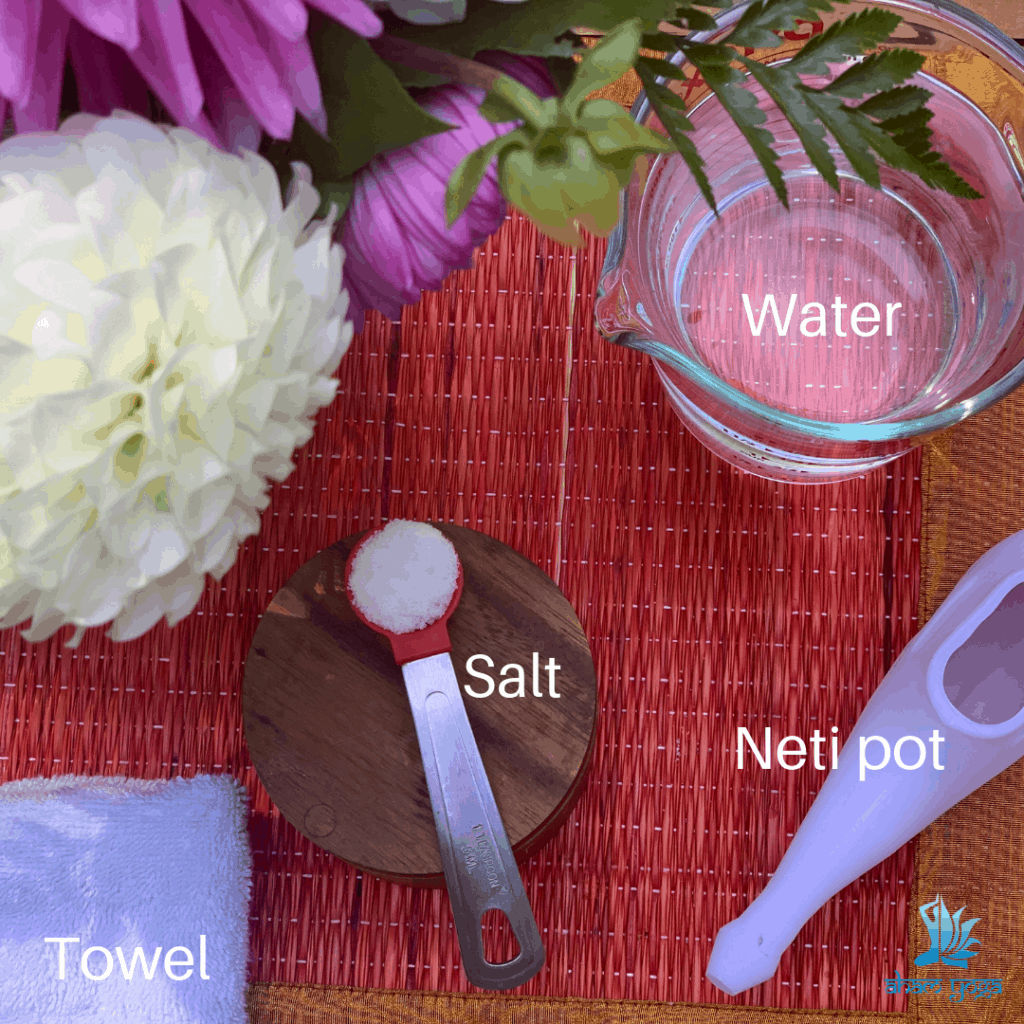We recently did an elaborate Jala Neti cleansing in our latest 300-hour yoga teacher training program. The questions from the teacher trainees, as well as stories of their previous experiences, prompted me to write this post today. I want to share all things Jala neti. Whether you’re a beginner or someone who’s already practicing this, I’m sure you’ll learn from this post.
There’s also an instructional video with this blog in case you want to skip to that right away, it’s here. I highly recommend you share this with anyone who’s fighting allergies with medications or has sinus issues.
What is Jala Neti?
Jala Neti is an ancient yogic practice of cleansing. In fact, it’s one of the ‘shatkarmas’ in yoga. That is one of the six cleansing techniques.
Jala = Water
Neti = Cleansing
Often wrongly called ‘Neti pot cleansing’, I prefer to call it Jala Neti or cleansing of the sinuses while teaching it.
Jala neti is the practice of pouring lukewarm saline water into one nostril and out through the other. We do this to cleanse the nasal passages, remove any blockages, and improve respiration.
What is the benefit of Jala Neti?
There are so many benefits of this ancient practice. Nowadays, I’ve seen it being recommended by doctors for adults and children to help with allergies, colds, sinuses, headaches, etc…While there are many benefits to doing Jala Neti, here are my top reasons to teach and share this practice:
- Clears the sinuses
- Increases alertness
- Removes mental sluggishness
- Reduces facial and mental tension
- Enhances clarity
- Improves respiration
- Enhances the sense of smell
- Excellent remedy for allergy season
- Beneficial during seasonal transitions
- Improves resistance to cold and blocked sinuses
- Improves ear and throat health
- Easily accessible to everyone
What we forget to do in Jala Neti?
My pet peeve in Jala Neti cleansing is that most people believe that the practice ends after pouring the water in and out of your nostrils. This is not true. A big part of the practice that’s often missed is getting the leftover water out of the nasal passages. There are techniques for this. If not, you’ll have a leaky nose all day;) and I’m sure you don’t want that in an important meeting or while teaching yoga.

What we need for Jala Neti?
- A neti pot (you can get them on Amazon)
- Salt ( I use good old kitchen salt, but you can use non-iodine salt if you prefer. There’s no real difference, it’s a marketing gimmick to sell specialized salt)
- Measuring spoon
- Something to heat the water – I use my microwave or stovetop. Avoid a kettle as it gets extremely hot
- A towel
Step by Step Instructions
- Warm 2 cups of water, add 1 tsp of salt and mix.
- Pour this into your neti pot, take your towel, and get ready to start. You can do this at your sink, shower or outdoors
- Before you get the water to your nose, pour a little on the back of your hand and do a heat test. It shouldn’t feel very hot. If you feel it burns you, please add cold water. You want water that’s just right not too hot.
- Before you begin, check which nasal passage is blocked, blow out on the back of your palm. Start with the opposite side of the blocked or less open nasal passage. For example, if you right blocked start with the left.
- Keep your feet shoulder-distance apart, bend your knees, push hips back, lean forward and turn your head to the side. Keep the head parallel to the ground. Bring the pot up to the nose, plug one nostril, open and breathe through your mouth.
- The water will slowly pass from one side and out through the opposite side. If you’re blocked this may not happen right away but you need to persist with more rounds.
- Do 2 to 3 rounds in total for both nostrils together.

How to get ALL the water out?
- As soon as one gets over, you may need to stop, clear out your nose. Blow into a towel and drain out some of the excess water so you can transition sides easily.
- At the end of your final round, you need to blow our your nasal passages with kapalabhati. A breathing practice where you forcefully exhale repeatedly and quickly. Blasting the air and water out of your nasal passages to clear out any saline water left. Most often people don’t do enough of this. Make sure to do at least 3 rounds of kapalabhati before walking away.
- Hanging in uttanasana (as shown in the picture below also is good) apart from kapalabhati.



If there’s burning or blockage?
If you nose burns, it could be one of two things.
- Your salt content is too high, reduce the amount of salt.
- Your water is too hot, it needs to be lukewarm.
If you notice you’re blocked, don’t stop. Sometimes working with a deviated septum or blocked sinuses may result in no water or a few drops out through the nasal passage. Persist! Do around 3 to 4 rounds in one session and repeat often.
How often to practice?
This is dependent on where you live, the climate and your needs. If you’re prone to allergies and sinuses – do this more often. It can be a daily practice. If not, once or twice a week is plenty. If that sounds like a lot – at least do this as the season’s transition.
I don’t have a disciplined practice but I do this as seasons transition and depending on how congested I feel. I also use this to enhance mental clarity. So if I’m working on something intense or have a big deadline I add this to my daily routine to boost my productivity and presence
Contra-Indications?
- Pregnancy – because you can’t do Kapalabhati when you’re pregnant
- Menstruation – same reason as above
- Elevated blood pressure – Kapalabhati can’t be done here
- Young kids – this can be too much for little ones, I would wait till 9 or 10 years old to teach this to young kids.
- It’s best learned under the guidance of a skilled teacher so that you love the practice and not hate it as it can go wrong sometimes
Are you going to try this at home? Let us know if you already do this or we’ve inspired you to try this. If you need to seek advice from a medical professional before you try this, please do so. We’d love to hear what you think in the comments below.


9 comments
Wow, very helpful! I made a comment on your youtube video so please answer that.
Hi, a little sensation in the back of my head.
Rest it was really easy, was worried will i be able to do it but worked well
Could you highlite the amount of salt to be used in 500 ml of water
I agree this happens a lot as well. The pain at the back of the head sometimes gets too much. I hope this issue is not of any concern.
Thanks alot
Hi my water actually doesn’t pass through my other nostril but leaks out of the pot
I tried this today and worked really well. Cleared out so much of septum. Thankyou!
Good Day Madam,
I saw your video on “Jala Neti for beginners – How to use a neti pot | Aham Yoga |”. This had motivated me and I gave it try.
I need some advice. When I pour water on one of the nostrils, the water doesn’t come out from the other. Instead, it comes out from the same nostril. Then I try to do it on the other nostril, still, it is the same. I thought my posture is wrong, and I tried the way exactly you recommended in the video, but the problem is the same.
Please advice.
Good relief
Your video and blog really helped me to learn. My mild constant headaches gone away with the help of Jal neti. I just followed your video step by step. Thanks
Comments are closed.